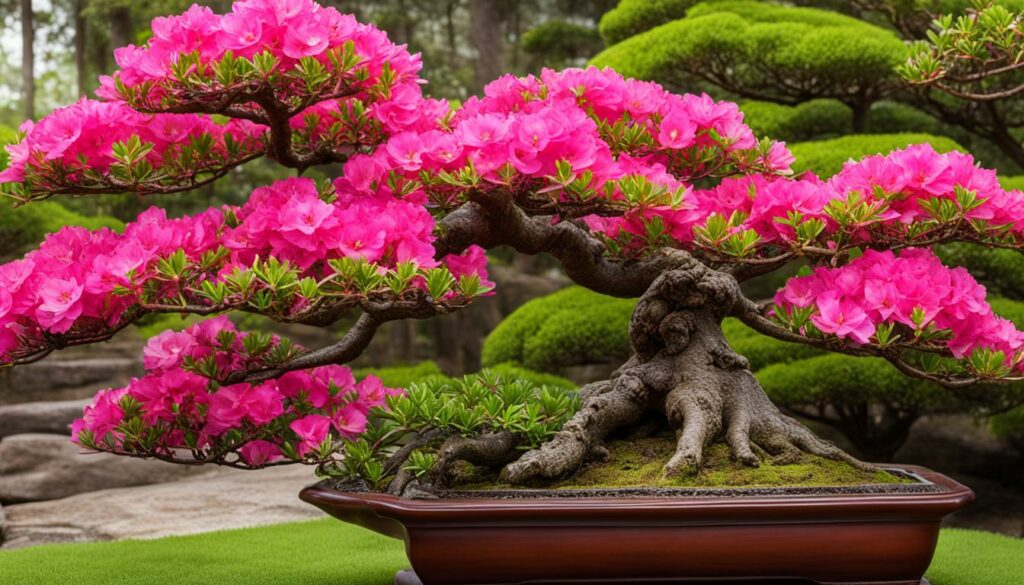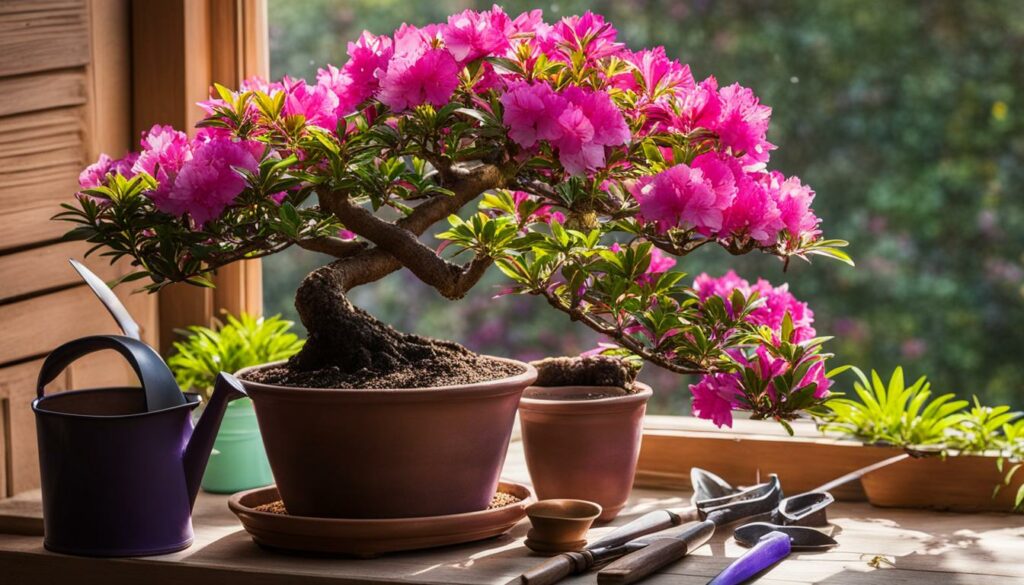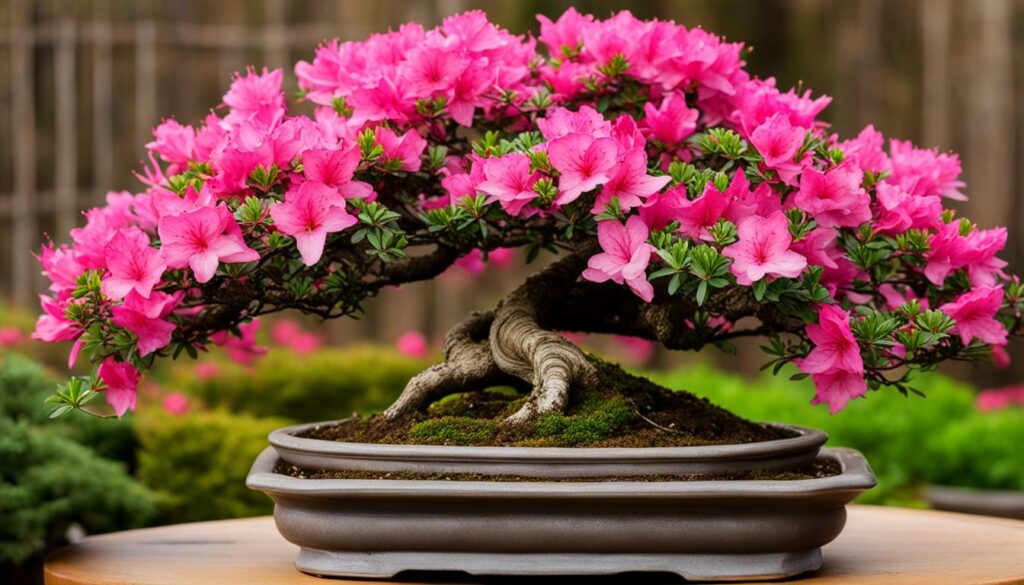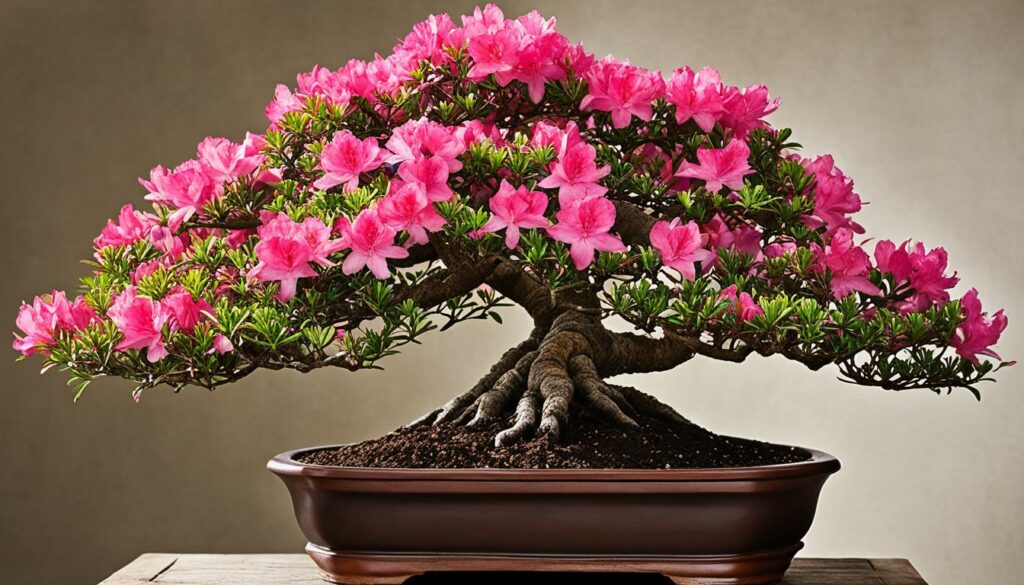Discover the mesmerizing beauty of the Bonsai Tree Species Azalea. This stunning variety adds vibrant charm and elegance to any space. In this section, you will learn valuable care tips to help you maintain the health and beauty of your Azalea bonsai tree and enjoy its enchanting blooms for years to come.
Key Takeaways:
- The Azalea bonsai tree is a beautiful flowering variety that belongs to the Rhododendron genus.
- Proper care practices, including watering, fertilizing, pruning, and repotting, are essential for maintaining a healthy and thriving Azalea bonsai tree.
- The art of styling and shaping your Azalea bonsai tree can enhance its natural beauty and form.
- The Azalea bonsai tree’s vibrant charm and elegance make it a captivating addition to any space.
- By following the care tips in this section, you can ensure that your Azalea bonsai continues to bloom and bring its unique charm and elegance.
Introducing the Azalea Bonsai Tree
Meet the Azalea Bonsai Tree, a stunning variety of flowering bonsai that belongs to the Rhododendron genus. Rhododendrons are a genus of woody flowering plants that cover a vast range of species, with Azaleas being one of the most popular. The charming beauty of the Azalea bonsai lies in its vibrant blooms that brighten up any space and add an alluring touch of elegance.
One of the most notable features of the Azalea bonsai is its beautiful and flamboyant flowers, which bloom in a variety of colors, including pink, red, purple, and white. These lovely blooms are a sight to behold and can last for several weeks, adding much-needed color and vitality to your space.
If you are looking to add the Azalea bonsai to your collection, it’s essential to take good care of it. Proper care will ensure the longevity of this flowering bonsai and help it thrive in your environment.
Caring for Your Azalea Bonsai Tree
The Azalea bonsai requires attentive care, and it’s crucial to ensure that the plant’s environment is suitable for its growth. Here are some essential care practices to keep your Azalea bonsai healthy and looking glorious:
- Placement: Place your Azalea bonsai in a bright, well-lit location that receives sufficient sunlight. Avoid placing the tree in direct sunlight during the hottest part of the day, as this may damage the leaves.
- Watering: The Azalea bonsai prefers moist but well-drained soil. Water the tree regularly, but make sure to avoid overwatering, as this may cause root rot. You can also use a humidity tray to maintain the required level of moisture around the tree.
- Fertilizing: Feed your Azalea bonsai with a balanced, water-soluble fertilizer during the growing season. Make sure to dilute the fertilizer as per the instructions on the package to avoid burning the roots.
- Pruning: Thoroughly prune your Azalea bonsai after the blooming season to encourage new growth and shape the tree. Make sure to use sharp, sterile tools to avoid damaging the plant.
- Repotting: Repot your Azalea bonsai every two to three years to ensure that the roots have enough space to grow. Use a suitable bonsai soil mix and prune the roots while repotting to maintain a healthy root system.

“The Azalea bonsai is a true masterpiece of nature. Its vibrant blooms and charming beauty can bring any space to life, while its delicate nature demands attention and care. Treat this bonsai with the love and respect it deserves, and you will enjoy its beauty for years to come.”
How to Care for Your Azalea Bonsai Tree
Now that you have an Azalea bonsai tree, it is important to care for it properly to ensure it continues to produce vibrant blooms. Follow these essential care tips:
Watering
The ideal frequency of watering your Azalea bonsai will depend on the type of soil mix and climate conditions. As a general rule, check the soil moisture level daily by inserting a wooden skewer into the soil. If it comes out dry, it is time to water the tree.
Avoid overwatering as this can damage the roots. When watering, ensure that the water reaches all parts of the soil, including the roots. You can place the tree in a tray filled with water for a few minutes for efficient watering.
Fertilizing
Apply fertilizer to your Azalea bonsai during the growing season, starting from early spring and ending in autumn. Use a balanced fertilizer with equal proportions of nitrogen, phosphorus, and potassium. Apply the fertilizer once every two to four weeks, following the manufacturer’s instructions carefully.
Pruning
Prune your Azalea bonsai after it has finished flowering to shape the tree. Remove dead or diseased branches and those that cross over each other. You can also pinch the tips of the branches to encourage branching and denser growth. Always use sharp and clean tools to prevent damaging the tree.
Repotting
Repotting your Azalea bonsai every two to three years is essential to ensure it has sufficient growing room and nutrients. Choose a suitable pot size and soil mix that promotes drainage and aeration.

Tip: Pruning and repotting are best done during the dormant period in winter to avoid damaging the tree’s growth during the flowering season.
By following these care tips, you can maintain the beauty and health of your Azalea bonsai tree, ensuring it produces vibrant blooms year after year.
Styling and Shaping the Azalea Bonsai Tree
Shaping and styling your Azalea bonsai tree requires patience, attention to detail, and skillful hands. It involves using various techniques to form and maintain the structure of your bonsai tree, enhancing its natural elegance and beauty. From wiring and pruning to branch placement and leaf trimming, there are several steps you can take to create a visually appealing composition.
When starting, consider the style you want your Azalea bonsai tree to portray. Common bonsai styles include formal upright, informal upright, slanting, cascading, and semi-cascade. Each style has its unique artistic expression, and it is essential to choose the one that aligns with your preferences and personal taste.
Wiring: Wiring is one of the most common techniques used in shaping bonsai trees. With the help of copper or aluminum wire, you can guide the growth and movement of branches and trunks, creating the desired shape. Always make sure not to wire too tightly, as it can damage the tree’s bark and growth. You can also remove the wire once the tree has set into the desired shape to avoid any marks or scars.

Pruning: Pruning helps to encourage branching, remove dead or diseased foliage, and maintain the shape of the tree. Be prudent in your cutting, as removing too much foliage or trimming at the wrong time can significantly impact the growth and development of your Azalea bonsai tree. Conduct light pruning throughout the year for optimal results.
Branch Placement: Branch placement plays a vital role in shaping your Azalea bonsai tree. By cutting off the upper growth and allowing the lower branches to thrive, you can achieve a convincing appearance of age and natural beauty. Always take time to assess your tree before placing branches, ensuring natural alignment and balance is maintained.
Leaf Trimming: Leaf trimming helps to control the tree’s growth and direct energy to specific areas, allowing for optimal growth. Ensure that leaves are trimmed to an appropriate size, avoiding cutting too much to avoid irreparable damage.
Styling and shaping your Azalea bonsai tree can be a highly rewarding process, allowing you to create a unique and visually pleasing composition that reflects your creativity and personality. Take the time to develop your skills, maintain your tree’s health, and enjoy the vibrant charm of the Azalea bonsai species.
Conclusion
By implementing the care tips outlined in this article, you can ensure that your Azalea bonsai tree flourishes and continues to exude its vibrant charm and elegance. Regular maintenance, including watering, fertilizing, pruning, and repotting, is key to promoting healthy growth and maintaining vibrant blooms. Remember to also consider the styling and shaping of your Azalea bonsai tree to enhance its natural beauty and form.
Don’t hesitate to seek advice from experienced bonsai growers or consult reputable online resources to ensure that you are providing the best care possible for your Azalea bonsai. Investing time and attention into the health and well-being of your Azalea bonsai tree will reward you with a stunning and captivating addition to your space.
FAQ
What is special about the Azalea bonsai tree?
The Azalea bonsai tree is known for its vibrant charm and elegance. It features stunning and colorful blooms that add a pop of color to any space.
What is the care required for an Azalea bonsai tree?
To care for your Azalea bonsai tree, you should water it regularly, ensuring the soil remains moist but not saturated. It thrives in a well-draining soil mix. Additionally, providing bright but indirect sunlight and maintaining proper humidity levels are crucial for its health. Regular pruning and repotting in the right season are also necessary for optimal growth.
How often should I water my Azalea bonsai tree?
You should water your Azalea bonsai tree when the top layer of soil feels dry to the touch. It is important to maintain consistent moisture levels but avoid overwatering, which can lead to root rot. Aim to water it thoroughly, allowing excess water to drain out of the pot.
Can I keep my Azalea bonsai tree indoors?
While the Azalea bonsai tree can be enjoyed indoors, it is important to provide it with adequate light and proper humidity levels. Place it near a bright window where it can receive indirect sunlight for several hours each day. Consider using a humidity tray or regular misting to increase humidity levels.
How do I shape and style my Azalea bonsai tree?
Shaping and styling the Azalea bonsai tree can be done through careful pruning and wiring. Regularly trim and shape the branches to achieve the desired form and enhance its natural beauty. Wiring can also help guide the branches into the desired position. Ensure you use proper techniques and tools to avoid damaging the tree.


